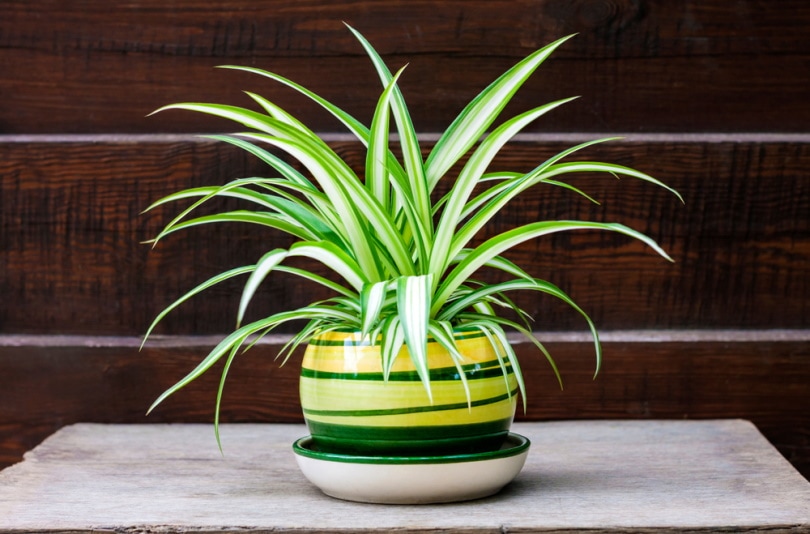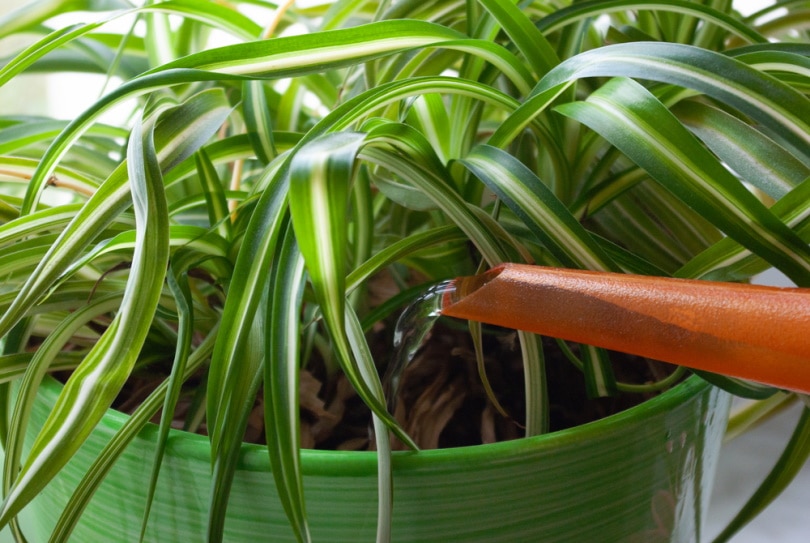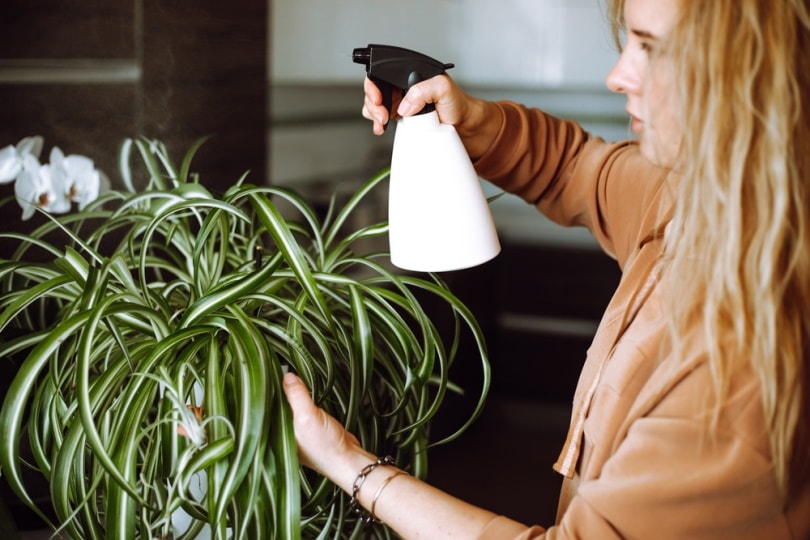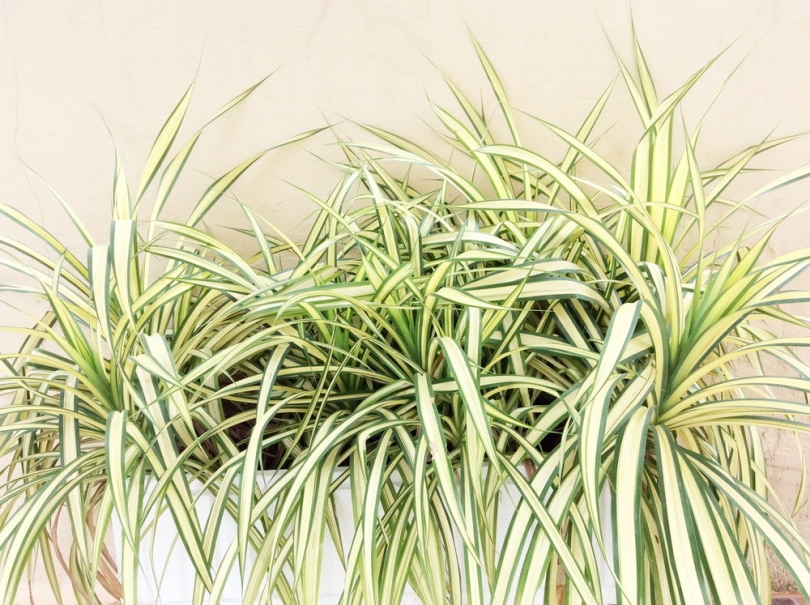How Much & How Often to Water Spider Plants: Facts & FAQ
-
Kristin Hitchcock
- Last updated:

Spider plants are usually considered succulents, so you don’t have to water them often. However, they still do need to be watered quite a bit, as they aren’t “true succulents.” This is not a plant that will thrive on abuse (as is often said for many succulents).
Typically, you’ll want to water your spider plant about weekly. The soil should dry completely between waterings. This plant is prone to fungal issues, which can be prevented if the soil is allowed to dry between waterings completely.
If the soil is still moist, we recommend waiting even if it means you go past the week mark. Too much watering can cause fungal growth and root rot.
The exact amount of water doesn’t matter all that much. We do recommend that you drench the soil so that all of it is moist, which helps ensure that it reaches to roots. However, as long as the pot has good drainage, you don’t have to worry about the plant getting too much water. The excess will simply run out of the drainage holes in the pot.
How Should Spider Plants Be Watered?
We recommend “flooding” the plant until the water runs out of the drainage holes at the bottom. Any watering beyond this won’t be helpful, as the water will continue running out. However, waiting until you see water dripping ensures that the water is soaked throughout the pot, which means that the roots will receive enough water.
You don’t just want to water the very top layer of soil, as it will evaporate before it soaks into the roots. Therefore, it won’t help the plant. Instead, you want to ensure that the water soaks all the soil down to the bottom.
As long as the pot has drainage holes, you don’t have to worry about overwatering the plant. The excess soil will simply run through the holes on the bottom.
We recommend putting a saucer underneath the plant to catch any extra water. Alternatively, you can place the plant into the sink and wait for the water to drain before replacing the plant in its normal location.
Empty this saucer as soon as the water has stopped draining. You don’t want to leave standing water near your plant, which may promote fungus and mold growth.
Do Spider Plants Need a Lot of Water?

Spider plants don’t need tons and tons of water. However, they do need to be watered more than most “desert” plants and succulents. While this plant has been adapted for drier conditions, its roots are adapted for water acquisition. Unlike other succulents, its stems and leaves are smooth and thin. They do not store water.
You should allow the soil to completely dry out between waterings. However, you do not want to leave the soil dry for too long. As soon as you notice that the soil is completely dry down to an inch or so, it is time to water your spider plant again.
Usually, most people will need to water their spider plant about every week or so. However, it does depend on your climate. Checking the soil dryness is far more accurate, as it accounts for the heat and humidity of your area.
Can I Use Tap Water for My Spider Plant?

Spider plants are sensitive to chlorine, which is usually added to tap water to prevent bacteria growth. In small amounts, chlorine is harmless to people. However, it can harm your spider plant if it builds up in the soil over time.
It is best to utilize rain water and filtered water for this purpose. These sources of water will not contain any chlorine or other chemicals that may be harmful to your plant.
If you only have tap water, you can let the water sit overnight. This process allows the chemicals to dissipate. Of course, the longer you let the water sit, the fewer chemicals will be left.
For emergency purposes, tap water is just fine. However, you don’t want to continuously use tap water, as the chemicals will build up over time.
What Causes Brown Tips on a Spider Plant?
One of the most common problems with spider plants is called “water stress”. This can mean either too much or too little water, and the plant usually shows its stress by developing brown tips on its leaves. Overwatering can cause the plant’s leaves to turn black or brown, but so can not enough moisture.
You should not allow your spider plant to sit in a saucer of water. You should also avoid letting the soil stay dry for an extended period. While these plants do like their soil to dry out between waterings, you should water it shortly after it is completely dry.
What Does an Overwatered Spider Plant Look Like?

An overwatered spider plant is usually pretty easy to identify. Usually, these plants become wilted, discolored, and generally look unhealthy. In some cases, they may also develop brown spots, yellow leaves, and brown tips. The leaves may also get soft, curled, or shriveled. In serious situations, you may see the roots of the plant rotting from the high moisture content in the soil.
As you’d guess, you can usually reverse these problems by limiting the amount of water you give to the plant. Allow the soil to completely dry out before you water it. Usually, this takes about a week. However, it will depend on your area.
For instance, if your area is more humid, you may need to water your spider plant every 10 days instead of once a week. Any of these signs of overwatering means that you’ve watered your plant too much, so it is a definite sign that you need to cut back.
Sadly, plants that have already developed root rot can’t always be saved. Sometimes, even by letting the soil dry out, you cannot kill the root cause of the rotting problem. However, letting the soil dry out completely is your best bet to save the plant.
Final Thoughts
Spider plants are sometimes grouped in with succulents. However, it is essential to realize that they are not true succulents. In other words, they are not designed to store water like many other succulents, so they need to be watered more often.
With that said, these plants are designed for drier climates, so they don’t need as much water as your average houseplant. They prefer their soil to dry completely between waterings, as they tend to be prone to root rot and similar issues.
However, once the top inch or so of soil is completely dry, it is time to water the plant again. Usually, this takes about a week or so. But it will depend on the air conditions in your home.
Featured Image Credit; TYNZA, Shutterstock
Contents

